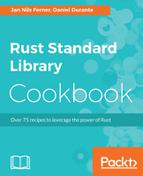The code in this recipe reads and writes the exact same CSV as the last recipe. The only difference is how we treat a single record. Serde helps us by enabling us to use plain old Rust structures for this. The only thing we need to do is derive our Planet structure from Serialize and Deserialize [9]. The rest is taken care of automatically by Serde.
Because we now use actual Rust structures to represent a planet, we create a record by calling serialize with a structure instead of write_record as before [42]. Looks way more readable, doesn't it? If you think that the example became a little bit too verbose, you could hide the actual object creation behind a constructor, as described in Chapter 1, Learning the Basics; Using the Constructor Pattern.
When reading a CSV, we also no longer have to manually access the fields of a StringRecord. Instead, deserialize() returns an iterator over a Result of an already deserialized Planet object. Again, look how much more readable this has become.
As you may have already guessed, you should use Serde whenever you can, as it helps you catch possible errors early by providing you with readability and compile-time type safety.
